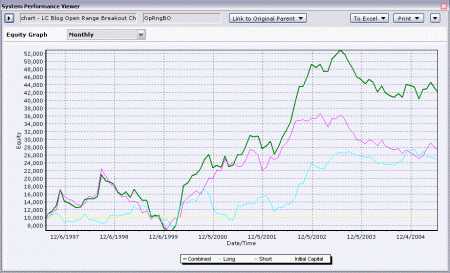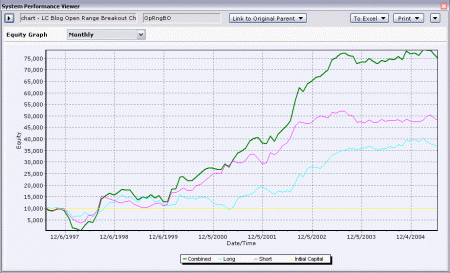Open Range Breakout Daytrading System
Open range breakout system is a well known concept. It is a variation of the classic N-bar breakout system. This concept is so widely talked about because it works. I will show you a new twist of the concept that is never discussed anywhere else.
Open Range Breakout
What does the open range breakout system do?
1. it identifies the highest price and lowest price reached since open upto the Start Time,
2. long on a stop at the highest price and short on a stop at the lowest price obtained in #1,
3. only trade once per direction, so at most 1 long and 1 short positions taken per day,
4. always exit at the end time of the day,
5. when the range of previous trading session is above certain threshold of the average range of the previous trading days, no trade is taken for the day
Here is the trading system, Open Range Breakout. You can use Indicator Manager to install this system in your NeoTicker.
The system is written in formula and can be installed into NeoTicker by just copying that into the indicator directory.
The Performance
Once you have installed the indicator, you can now set up your chart.
The example I am going to use is 10-min ES, going all the way back to 1998. Remember to set the chart to the appropriate time range as the regular trading session of ES is 9:30 AM to 4:15 PM Eastern Time.
When you apply the system, remember to set your price multiple to 50 and min tick size to 0.25. The commission I used in my testing is 2.5 per trade.
Here is the result of the system.
As a core system, with no bells and whistles, it works reasonably well.
One issue, though, is that the performance lately is not that good.
Our Twist
Go into the Chart Manager and change the chart’s trading time range from the original 9:30 AM – 4:15 PM, to 10:00 AM – 4:00 PM.
This technique is known as Data Reduction, which I have discussed in more details in another article titled “Daytrading the Emini” in the Technical Analysis of Stock & Commodities magazine, August 2003 issue.
Here is the performance of the system using reduced data.
You probably do not believe it is the same system with the same default parameters, don’t you?
Conclusion
To improve a trading system does not necessarily involves a lot of parameter twistings. The more important thing to do is to understand why the system is not doing what it supposed to and find logic solutions to resolve the problem.
In this case, it is obvious that the opening 20 to 30 minutes is very chaotic and so is the last 15 minutes of trading. By removing those information, we improved the stability of our signals, thus the improvement in performance.









